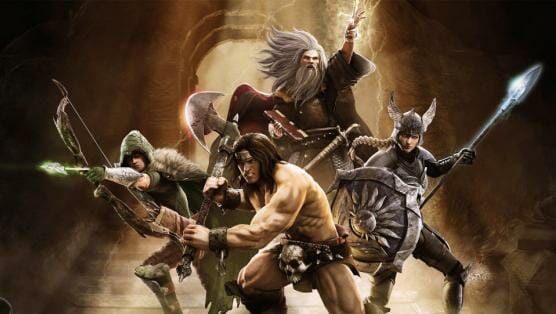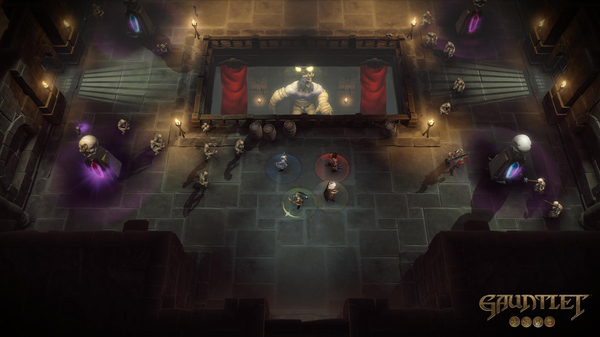
I’m no game designer, but I think it must have been tempting for Arrowhead Games to push their version of Gauntlet down the path of the grind. Take a five-hour game and make it a twenty-hour one by adding experience points, skill trees, big damage numbers, then coax the player to run through levels over and over to make progress. It fits the style of game they’re making—slaughtering waves of standard D&D monsters through familiar castles and caverns has a longer lifespan when you have a carrot to look forward to.
It certainly would’ve felt at home in the Gauntlet series, whose previous entries have been time-killing slogs through level after level (Gauntlet: Dark Legacy comes to mind). It also wouldn’t have been out of place in the current gaming zeitgeist, where time sinks like Diablo III and Destiny dominate the conversation simply because they require huge time commitments, remaining in players’ rotations longer than most other titles as a result.
If there was temptation to do that, I’m glad Arrowhead didn’t cave to it. There is some progression in Gauntlet, mind you: As I made my way through each level, I could use the gold I’d earned to buy extra powers like summoning tornados or speed bursts, and over time my characters got slightly stronger when I completed challenges. Making my Elf archer a meaner monster-killing machine was an afterthought, though: big powers require single-use potions, and I handily cleared most of the game without them. I didn’t notice the small percentage increases the game grants after clearing each level, either. The numbers are there and they’re working the way they do in any game, but you don’t have to know them to play.
Without the need for gear or levels, I was left to focus almost entirely on what I did in each level rather than what I owned. If I died, it wasn’t because I wasn’t equipped for that particular stage, or because my friends and I were underleveled; we didn’t coordinate, or I bungled a crucial opportunity to dodge out of the way of the mobs coming at us and died. I simply needed to do better, not have better stuff. I’ve put more time into grinds in recent months than I’d care to admit, so it’s refreshing to have something to pick up and put down at my leisure, time investment be damned.
I might prefer the new approach, but the drawbacks to not going for the grind definitely show. Once the campaign is finished, alone or with friends, there’s not much reason to go back to levels unless you’re having enough fun killing monsters to simply want to do it again at a higher difficulty. If you’re playing solo, longer sessions yield diminishing returns without the lure of the Next Big Item to string you along. I’d play through one complete level made up of three stages, load up the next and immediately feel like stopping. It doesn’t help that every level boils down to the same cycle of regular dungeon crawl, hurried dungeon crawl, and arena fight, with a boss fight thrown in every once in a while for good measure.
How do these levels actually play? Well, that depends on your class. The differences between the Warrior, Valkyrie, Elf and Wizard are fundamental enough that I felt like I was playing a different game whenever I switched between them. The Warrior is classic Gauntlet, emphasizing brawn and maneuvering since you have no real way to avoid damage but can take it readily; the Valkyrie is a more action-oriented game like The Legend of Zelda, with faster abilities and a shield to block damage if you get surrounded; the Elf is Smash TV or any other twin-stick shooter where you kite enemies from afar; the Wizard is Arrowhead’s previous game, Magicka, where button combinations correspond to different spells. I’m not particularly impressed by the Warrior, but every other class felt fresh enough that I didn’t mind running through a few levels again just to see how every class overcame a particular challenge. In a group, the differences shine; a Valkyrie can focus solely on blocking projectiles and pushing back enemies while the Elf makes quick work of them from afar without fear.
It’s for this reason that the lack of progress bars is so vital. Grouping together in most games catered around experience points usually requires everyone to play in lockstep or risk being affected by a level disparity. No worry of that here—a player who’s logged several hours can jump in to a newbie’s game without hindering either player’s experience. That the co-op fleshes out each of the classes makes the levels all the more disappointing: by the time I figured out a rhythm with my group, we had run out of levels to truly explore what we could accomplish together.
I’ll take a fun night cut short over investing in yet another time sink, though. And while Gauntlet looks like an RPG in almost every way, it ultimately doesn’t play like one, and I wouldn’t have it otherwise. If it were, it’d be buried by the current titans of the genre, as well as its own bland level design and aesthetic. As it is, it’s a great way to kill a night or two with a group of friends as you figure out your characters, how to work together, and inevitably create your own co-op setups for success. And despite the sweeping changes to the series’ formula, that’s Gauntlet.
Gauntlet was developed by Arrowhead Games and published by Warner Brothers Interactive Entertainment. It is available for PC.
Suriel Vazquez is a freelance writer who couldn’t have felt more betrayed by Gauntlet: Seven Sorrows when it was the main event at an all-nighter and the game ended after only 3 hours. You can follow him @SurielVazquez.
